SSC JE Civil Past Year Paper Technical - 2015 | Civil Engineering SSC JE (Technical) - Civil Engineering (CE) PDF Download
CIVIL & STRUCTURAL
Q.101. The minimum percentage of steel in R.C.C. slab using mild steel reinforcement in given by :
(a) 0.35%
(b) 0.12%
(c) 0.15%
(d) 0.30%
Ans. (c)
Solution.
Minimum reinforcement
The mild steel reinforcement in either direction in slabs shall not be less than 0.15 percent of the total cross-sectional area. However, this value can be reduced to 0.12 percent when high strength deformed bars or welded wire fabric are used.
Q.102. To obtain very high strength concrete, it is necessary to use very fine grained
(a) Volcanic Scoria
(b) Granite
(c) Magnetite
(d) Barite
Ans. (b)
Solution.
As granite is strongest rock, we can use it for high strength concrete.
Q.103. Which of the following type of lime is used for underwater constructions
(a) Fat lime
(b) Quick lime
(c) Slaked lime
(d) Hydraulic lime
Ans. (d)
Solution.
Fat lime
- Also known as high calcium lime, pure lime, rich lime or white lime.
- Suitable for whitewashing and plastering.
Hydraulic lime - Also known as the water lime as it sets underwater.
- Contains silica, alumina and iron oxide in small quantities.
- Suitable for making mortar and used for masonry construction.
Quicklime - Calcium oxide (CaO), commonly known as quicklime or burnt lime or lime.
- Calcium oxide is a key ingredient for the process of making cement.
- Used for Plaster work and under water construction.
Slaked lime - Calcium hydroxide (Ca(OH)2), traditionally called slaked lime.
- It has many names including hydrated lime, builders’ lime, slack lime, cal, or pickling lime.
- Used in road construction, to improve the quality of excessively plastic subgrade soils.
Q.104. Which one of the following has least bearing capacity ?
(a) Loose gravel
(b) Hard rocks
(c) Soft rocks
(d) Compact gravel
Ans. (a)
Solution.
Loose gravel has least bearing capacity among Hard rocks, Soft rocks and Compact gravel.
Q.105. Factor of safety is the ratio of :
(а) Bearing stress and working stress
(b) Yield stress and working stress
(c) Tensile stress and working stress
(d) Compressive stress and working stress
Ans. (b)
Solution.
Factor of safety = Yield stress/Working stress
Q.106. For lined canals, the freeboard is measured from the :
(а) Full supply level to the top of the lining
(b) Full supply level to the top of the bank
(c) Top of the bank to the top of the lining
(d) Full supply level to the top of the dowel
Ans. (a)
Solution.
- For lined canals, the freeboard is measured from the Full supply level to the top of the lining.
- For unlined canals, the freeboard is measured from the Full supply level to top of the bank
Q.107. The property of a material by which it gets permanent deformation under a load which is not recovered after removal of load is called
(a) Elasticity
(b) Rittleness
(c) Ductility
(d) Plasticity
Ans. (d)
Solution.
The property of a material by which it gets permanent deformation under a load which is not recovered after removal of load is called Plasticity.
Q.108. The concrete having a slump of 6.5 cm,is said to be:
(a) Plastic
(b) Dry
(c) Earthmoist
(d) Semi-plastic
Ans. (a)
Solution.
The concrete having a slump of 6.5 cm, is said to be plastic.
Q.109. Capillary rise is a phenomenon that is attributed to the following property of fluid
(a) Vapour pressure
(b) Viscosity
(c) Density
(d) Surface tension
Ans. (d)
Q.110. The value of Cv for sharp edged orifice is generally
(а) 0.98
(b) 0.95
(c) 0.96
(d) 0.97
Ans. (a)
Solution.
The value of Cv for sharp edged orifice is generally 0.98.
Q.111. As a cheap alternative, the fineness of cement is tested by using
(a) IS 100μ sieve where at least 90% (by weight) should be retained
(b) IS 90μ sieve where at least 90% (by weight) should pass
(c) IS 90μ sieve where at least 95% (by weight) should pass
(d) IS 100μ sieve where at least 90% (by weight) should pass
Ans. (b)
Q.112. Strain energy due to sudden axial load is given by:
σ : resultant stress
P : Axial load
A : Detomator
∈ : Strain
E : modulous of elasticity
(a)
(b) σ . ∈
(c) PΔ
(d)
Ans. (c)
Solution.
Strain energy due to gradually applied axial load is given by
Now axial deformation due to sudden applied axial load is twice the axial deformation due to gradually applied axial load.
Hence, Strain energy due to suddenly applied axial load will be
Q.113. The maximum permissible stress for hand driven river in axial tension is :
(a) 250N/mm2
(b) 80N/mm2
(c) 90 N/mm2
(d) 100 N/mm2
Ans. (b)
Q.114. Measurement of pressure difference between two points is, generally done by using
(a) Venturimeter
(b) Pitot tube
(c) Different manometer
(d) None of the above
Ans. (c)
Solution.
Differential manometer is used to measure the pressure difference between two points in a fluid contained in a -pipe or a vessel. On the other hand Simple manometers are those which measure pressure at a point in a fluid contained in a pipe or a vessel.
Q.115. Calcium chloride added in concrete acts as:
(a) Retarder
(b) Accelerator
(c) Air entraining agent
(d) Plasticizer
Ans. (b)
Solution.
Calcium chloride (CaCl2) added in concrete acts as Accelerator or it is a admixtures result in early setting and hardening or concrete and increased shrinkage.
Q.116. The following document contains detailed description of all items of work excluding their quantities, along with the current rates :
(a) Analysis of rates
(b) Tender document
(c) Abstract estimate
(d) Schedule of rates
Ans. (d)
Solution.
Schedule of Rate is a list of rates of various items of works. This type of document contains detailed description of all items of work excluding their quantities, along with the current rates.
Q.117. Specific gravity has a unit :
(a) g/cc
(b) kg/m3
(c) N/m3
(d) No unit-dimensionless
Ans. (d)
Solution.
Specific gravity of liquid It is the ratio of specific weight (or mass density) of a liquid to the specific weight of standard fluid (pure water) at a standard temperature.
Hence it is dimensionless.
Q.118. To construct a massive dam the type of cement used is :
(a) Blast furnace slag cement
(b) Low heat cement
(c) Rapid hardening cement
(d) Ordinary Portland cement
Ans. (b)
Q.119. The size of a fillet weld is indicated by:
(a) Size of the plate
(b) Side of the triangle of fillet
(c) Throat of the fillet
(d) Length of fillet weld
Ans. (b)
Solution.
The size of a fillet weld (S) depends on side of the triangle of fillet.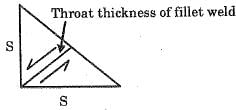
Q.120. In limit state method of design, for bars in compression the values of bond stress shall be .
(a) Decreased by 25%
(b) Increased by 20%
(c) Decreased by 20%
(d) Increased by 25%
Ans. (d)
Solution.
For bars in compression, the values of bond stress for bars in tension shall be increased by 25 percent.
Q.121. The main gas liberated from an anaerobic sludge digestor is :
(a) NH3
(b) CO
(c) C02
(d) CH4
Ans. (d)
Solution.
During the anaerobic digestion approximately 70% of the methane (CH4) produced
Q.122. Spacing of stirrups in a rectangular beam is :
(a) Increased at the ends
(b) Kept constant throughout the length
(c) Decreased towards the centre of the beam
(d) Increased at the centre of the beam
Ans. (d)
Solution.
Spacing of stirrup in a rectangular beam increased at the centre of the beam.
Q.123. The minimum percentage of longitudinal reinforcement in RCC column is :
(a) 12
(b) 0.6
(c) 0.8
(d) 1.0
Ans. (c)
Q.124. 
The beam shown in Fig. is :
(a) Free cantilever beam
(b) Single overhanging beam
(c) Doubel overhanging beam
(d) Proper cantilever beam
Ans. (b)
Solution.
An overhanging beam is one in which the supports are not situated at ends i.e. one or both the ends project beyond the supports. Thus it is single overhanging beam.
Q.125. The slende mess ratio of a coloumn is zero when its length :
(a) Effective length is equal to Actual length
(b) Is very large
(c) Is equal to its radius of gyration
(d) Is supported on all sides throughout its length
Ans. (d)
Solution.
Slenderness ratio is given by λ = 1/r
The radius of gyration (r) of a section is given by
Q.126. Most important constituents of cement are :
(a) C3A and C2S
(b) C3S and C3A
(c) C3S and C2S
(d) C3A and C4AF
Ans. (c)
Solution.
| Bouge’s compounds (% age) | Contribution |
| C4AF | 08 - 14 (about 9%) |
| C3A | 05 - 11 (about 10.5%) |
| C2S | 25 - 40 (about 32%) |
| C3S | 25 - 50 (about 40%) |
Q.127. Which of the following has least carbon content ?
(a) Wrought Iron
(b) Cast Iron
(c) Mild steel
(d) Pig steel
Ans. (a)
Solution.
| Material | Carbon content in %age |
| Steel | 0.25 - 1.5 |
| Wrought iron | 0.0 5 -0.1 5 |
| Cast iron | 1.7-4.5 |
| Pig iron | 3.5 -4.5 |
Q.128. When R is the radius of the curve (in meters), D is the degree of curve (in degrees) and length of the chord is 30m, then the relation between R and D is :
(a) R = 5400/D
(b) R = 1520/D
(c) R = 1720/D
(d) R = 4500/D
Ans. (c)
Solution.
Radius of curve (R) and degree of curve (D)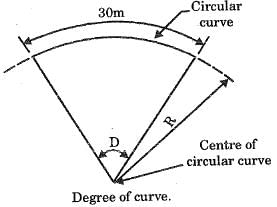 D°/360 = 1/2πR
D°/360 = 1/2πR
- For 30 m chain length (1 = 30 m)
Degree of curve, D° =
Radius of curve, R =
- For 20 m chain length (1 = 20 m)

Q.129. The floor area includes the area of the balcony upon
(a) 25%
(b) 85%
(c) 75%
(d) 50%
Ans. (d)
Solution.
Floor area of a building is the sum area of floor in between walls and consists of floor of all rooms verandahs passages corridors staircase room, entrance halls, kitchen, store, bath and latrine etc. The floor area includes the area of the balcony upto 50%.
Q.130. The increase in the strength of concrete with time is :
(a) Linear
(b) Non-linear
(c) Asymptotic
(d) All of the above
Ans. (b)
Solution.
As the graph of indicates that the increase in the strength of concrete with time is non-linear.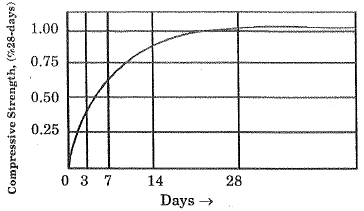
Strength-gain curve
Q.131. Generally concrete cubes are tested measure concrete’s
(a) Compressive strength
(b) Tensile strength
(c) Twisting strength
(d) None of the above
Ans. (c)
Solution.
Generally concrete cubes are tested to measure concrete’s characteristic compressive strength of 150 mm cube after 28 days.
Q.132. In a singly reinforced beam if the stress in concrete reaches its allowable limit earlier than the steel reaches its permissible limit, the beam section is called:
(a) Critical section
(b) Under reinforced section
(c) Over feinforced section
(d) Economic section
Ans. (c)
Solution.
In a singly reinforced beam, if the stress in concrete reaches its allowable limit earlier than the steel reaches its permissible limit, the beam section is called over reinforced section.
Q.133. Which of the following is a dimensionless quantity ?
(a) Shear force
(b) Stress
(c) Strain
(d) Modulus of elasticity
Ans. (c)
Solution.
Strain is dimensionless quantity, i.e.
Q.134. Weight of one bag of cement is :
(a) 70 kg
(b) 50 kg
(c) 60 kg
(d) 65 kg
Ans. (b)
Solution.
Weight of one bag of cement = 50 kg
Unit weight of cement bag = 1440 kg/m3
Volume of one bag of cement =
Q.135. The flow constant ‘f in Darcy Weisbach equation for head loss in piped flows has a unit of :
(a) No unit-diversion less
(b) m
(c) m/sec
(d) Kg-m/sec
Ans. (a)
Solution.
f = Darcy-Weisbach resistance coefficient has dimensionless [M°Z°T°]
Q.136. Steel corrodes in exposure of air and moisture and rust has :
(a) 2.5 times the volume of steel
(b) 0.5 times the volume of steel
(c) Equal volume compared to amount of steel rustad
(d) Twice the volume of steel
Ans. (a)
Solution.
Steel corrodes in exposure of air and moisture and rust has 2.5 times the volume of steel.
Q.137. In the quadrantal bearing system, a whole circle bearing of 293°30' can be expressed as :
(a) N 23°30'W
(b) W 23°30'N
(c) N 66°30'W
(d) S 113°30'N
Ans. (c)
Solution.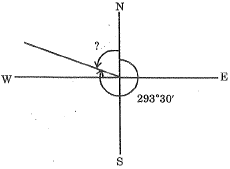 Reduced bearing or Quadrantal bearing is the angle which a line makes from North or South Pole whichever may be near. It’s value is from 0° to 90°.
Reduced bearing or Quadrantal bearing is the angle which a line makes from North or South Pole whichever may be near. It’s value is from 0° to 90°.
Hence, In the quadrantal bearing system, a whole circle bearing of 293°30' can be expressed as N66°30'W.
Q.138. Workability of concrete is directly proportional to :
(i) Time of transit
(ii) Wate cement ratio
(iii) Gradign of aggregate
(iv) Strength of aggregate
(v) Aggregate cement ratio
(a) (iii), (iv), (v)
(b) (i), (ii), (iv)
(c) (ii), (iii), (v)
(d) (ii), (iii)
Ans. (d)
Q.139. A 40 cm diameter circular timber column is 4 m long. The slenderness ratio of the column is :
(a)
(b) 10
(c) 20
(d) 40
Ans. (d)
Solution.
Slenderness
Now, radius of gyration,
Hence slenderness,
Q.140. The percentage of the fine aggregate of fineness modulus 2.6 to be combined with coarse aggregate o f fineness modulus 6.8 o f ob ta in in g the aggregates of fineness modulus 5.4, is :
(a) 60%
(b) 30%
(c) 40%
(d) 50%
Ans. (d)
Solution.
The percentage of the fine aggregate
Q.141. Administrative head of public works department who is directly responsible to Government is :
(a) Assistant Engineer
(b) Executive Engineer
(c) Superintending Engineer
(d) Chief Engineer
Ans. (d)
Solution.
Administrative head of public work department who is directly responsible to government is Chief Engineer.
Q.142. The load factor applied to wind and seismic loads in design of steel structures is :
(a) 2.2
(b) 1.3
(c) 1.5
(d) 1.8
Ans. (b)
Solution.
The load factor applied to wind and seismic loads in design of steel structures is 1.3.
Q.143. The minimum diameter of longitudinal reinforcement in RCC column should not be less than :
(a) 16 mm
(b) 6 mm
(c) 8 mm
(d) 12 mm
Ans. (d)
Solution.
The minimum diameter of longitudinal reinforcement in RCC column should not be less than 12 mm.
Q.144. Generally the ratio of different ingredients (Cement Sand and aggregate) in concrete mix of grade M2O
(a) 1 : 2 : 4
(b) 1 : 1 5 : 3
(c) 1 : 3 : 6
(d) 1 : 1 : 2
Ans. (b)
Q.145. Fineness test of cement gives us an estimate of :
(a) Workability of concrete
(b) Heat of hydration
(c) Rate of hydration
(d) Durability of concrete
Ans. (c)
Solution.
The fineness of cement is responsible for the rate of hydration and hence the rate of gain of strength and also the rate of evolution of heat.
Q.146. The type o f surveying which requires least, office work is (least calculation) :
(a) Theodolite surveying
(b) Tacheometry
(c) Trigonometrical levelling
(d) Plane table surveying
Ans. (d)
Solution.
Plane table surveying requires least office work and least calculation.
Q.147. Admixture which cause early setting and hardening of concrete are called
(a) Air entrainign agents
(b) Workability admixture
(c) Accelerators
(d) Retarders
Ans. (c)
Solution.
Admixtures which results in early setting and hardening of concrete are called accelerators.
Q.148. Basalt stone is by nature :
(a) Meta morphic
(b) Volcanic
(c) Plutonic
(d) Sedimentary
Ans. (c)
Solution.
Igneous rock is formed through the cooling and solidification of magma or lava. Igneous rock may form with or without crystallization, either below the surface asintrusive (plutonic) rocks or on the surface as extrusive (volcanic) rocks.
- Volcanic rocks are rocks formed when lava cools and solidifies on the earth’s surface.
Ex-Basalt. - Plutonic rocks are rocks formed when magma cools and solidifies below the earth’s surface. Ex-Granite.
Q.149. In open channels 9 maximum velocity occurs :
(a) Just below the free surface
(b) At the surface
(c) Near the channel bottom
(d) In the mid-depth of flow
Ans. (a)
Solution.
Open channels, maximum velocity occurs Just below the free surface which is shown in fig.
Typical Patterns of Velocity Distribution in Various Channel Section


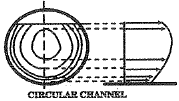
Q.150.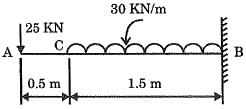
For the cantilever beam shown in Fig. the value of shear Force at fixed end is :
(a) 100 kN
(b) 70 kN
(c) 80 kN
(d) 90 kN
Ans. (d)
Solution.
Shear force at fixed end,
SB = 25 + 30 x 1.5 = 70kN
Q.151. In a simply supported beam of span, L subjected to Uniformly Distributed Load (UDL) of intensity W kN/m over it’s entire length the maximum bending is given by the expression:
(a)
(b)
(c) 
(d) WL
Ans. (a)
Solution.
Simply supported beam with UDL
 B.M. at section X is given by
B.M. at section X is given by
For maximum value of M , put
∴ 
∴ x = 1/2
Thus

Q.152. The relationship between void ratio ‘e’ and porosity ‘n’ is :
(a)
(b) e = n(l + e)
(c)
(d)
Ans. (b)
Solution.
Relationship between void ratio ‘e’ and porosity 'n' -
∴ n = e(l - n)
∴
Q.153. When l cm on a map represents 10 m on the ground, the representative fraction of the scale is :
(a) 1/10000
(b) 1/10
(c) 1/100
(d) 1/1000
Ans. (d)
Solution.
R.F. (Representative Fraction) which is always written with the map distance as 1 and is independent of any unit of measure.
Hence 1 cm on a map represents 10 m on the ground, the representative fraction of the scale is
RF = 1/1000
Q.154. A simply supported beam of span ‘L’ is loaded with downward uniformly distributed load of intensity W/mp over it’s entire length. Which of the following orientation of T-beams is preferred to resist bending ?
(a)
(b)
(c)
(d)
Ans. (b)
Solution.
Orientation and shear stress diagram of T-beam is preferred to resist bending is shown in figure.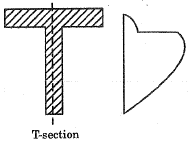
Q.155. The total energy line lies over the hydraulic gradient line by an amount equal to :
(a) Sum of pressure, velocity and datum heads
(b) Pressure head, P/γ
(c) Velocity head, v2/2g
(d) Datum head, z
Ans. (c)
Solution.
Hydraulic Grade Line (HGL)
It is the line which joins the peizometric head at various points in flow.
Peizometric head = ( P/w + Z)
Total Energy Line (TEL)
The line which joints total energy is known as TEL.
Total head = P/w + V2/2g + Z w
Hence, the total energy line lies over the hydraulic gradient line by an amount equal to Velocity head, v2/2g
Q.156. Diameter of a rivet hole is made larger than the diameter of the river by
(a) 0.5 mm
(b) 1.0 mm
(c) 3 mm
(d) 2.0 mm
Ans. (d)
Q.157. A flyover seggregates traffic with respect to :
(a) Direction
(b) Grade
(c) Speed
(d) Class of vehicle
Ans. (b)
Solution.
A flyover segregates traffic with respect to Grade. A highway grade separation is achieved by means of vertical level.
Separation of intersecting roads by means of a bridge thus eliminating all crossing conflicts at the intersection.
Q.158. For producing electricity, following combination of machines will be required :
(a) Electric Motor + Pump
(b) Hydraulic Turbine + Generator
(c) Hydraulic Turbine + Electric Motor
(d) Generator + Pump
Ans. (c)
Solution.
For producing electricity, following combination of machines will be required Hydraulic turbine +Electric motor.
Q.159. Irrigation efficiency o f an irrigation system is the ratio of
(a) Water reaching the farm to water delivered from the source
(b) Crop yield to total amount of water used in a field
(c) Water actually stored in root zone to water delivered to the farm
(d) Water actually utilised by growing crops to water delivered from the source
Ans. (d)
Solution.
Irrigation efficiency of an irrigation system is the ratio of Water actually utilised by growing crops to water delivered from the source.
Q.160. The specific gravity of bitumen is
(a) 2.09
(b) 0.8
(c) 0.9
(d) 1.09
Ans. (d)
Solution.
The specific gravity of bitumen is 1.09.
Q.161. The ratio of normal stress to normal strain within elastic limits is called :
(a) Young’s Modulus
(b) Shear Modulus
(c) Poisson’s Ratio
(d) Bulk Modulus
Ans. (a)
Solution.
The ratio of normal stress to normal strain within elastic limits is called Young’s Modulus.
The ratio of direct stress to volumetric strain within elastic limits is called Bulk Modulus.
The Ratio of shear stress to shear strain within elastic limits is called Modulus of Rigidity.
The ratio of lateral strain to linear strain is called Poisson’s ratio.
Q.162. Gravel and sand belongs to the following category of soils
(a) Alluvial
(b) Cohesive
(c) Expansive
(d) Marine
Ans. (a)
Solution.
Gravel and sand are fragmented sediments of rock are transported by river or stream are settled on river bed and surrounding regions. These are Alluvial or Fluvial soil.
Q.163. The shape of Bending Moment Diagram in a beam subjected to only Uniformly Distributed Load (UDL) is :
(a) Constant
(b) Cubic parabola
(c) Parabola
(d) Triangular
Ans. (c)
Solution.
To prevent sulphate attack in concrete, for preparing concrete mix , water pH must be within 6-9.
Q.164. To prevent sulphate attack in concrete, for preparing concrete mix, water pH must be within
(a) 7 -1 0
(b) 4 - 6
(c) 5 - 7
(d) 6 - 9
Ans. (d)
Solution.
To prevent sulphate attack in concrete, for preparing concrete mix , water pH must be within 6-9.
Q.165. For subcritical flow, the froude number is :
(a) Not equal to one
(b) Less than one
(c) Greater than one
(d) Equal to one
Ans. (b)
Solution.
Froude number
Where V = mean velocity of flow
D = hydraulic depth
- If Fr < 1, Flow is sub critical or streaming or tranquil. It is a stable type of flow.
- If Fr = 1, Flow is critical.
- If Fr > 1, Flow is supercritical or shooting flow or Torrential flow.
Q.166. The permissible bending stress in working stress method of design of column base is considered equal to :
(a) 0.87 fy
(b) 0.6 fy
(c) 0.67 fy
(d) 0.75 fy
Ans. (d)
Q.167. In single laced column construction, the thickness of the flat lacing bars shall not be less than :
(а) 1/15th of the width of the lacing bar 1
(b) 1/30th of the effective length of single lacing 1
(c) 1/40th of the effective length of single lacing 1
(d) 1/10th of the width of the lacing bar
Ans. (c)
Solution.
The minimum thickness of the flat lacing bars shall not be less than
- 1/40th of the effective length of single 40 lacing.
- 1/60th of the effective length of double 60 lacing.
Q.168. The most accurate instrument for measuring horizontal and vertical angles is :
(a) Theodolite
(b) Dumpy level
(c) Compass
(d) Tape and chain
Ans. (a)
Q.169. The quantity of wood for the shutters of doors and windows its calculate in :
(а) m3
(b) lump-sum
(c) m
(d) m2
Ans. (d)
Solution.
The quantity of wood for the shutters of doors and windows is calculated in m2
Q.170. The plane of a building is in the form of square with centreline dimensions of outer walls as 14.7 m x 14.7 m. If the thickness of the wall in superstructure is 0.30m , then its plinth area is :
(a) 234 m2
(b) 150 m2
(c) 216 m2
(d) 225 m2
Ans. (d)
Solution.
The Plinth area should be calculated for the covered area by taking external dimension of the building at the floor level.
Hence Plinth area = (14.7 + 0.3) m x (14.7 + 0.3) m
= 225 m2
Q.171. The counter lines can cross one another on map only in the case of :
(а) An overhanging cliff
(b) A vertical cliff
(c) A valley
(d) A ridge
Ans. (a)
Q.172. The purpose of stiffeners in a plate girder is to :
(а) Prevent buckling of web plate
(b) Reduce the shear stress
(c) Take care of bearing stress
(d) Increase the moment carrying capacity of the girder
Ans. (a)
Q.173. A fluid, which is incompressible and is having no viscosity
(a) Ideal fluid
(b) Real fluid
(c) Newtonian fluid
(d) Non Newtonian fluid
Ans. (a)
Q.174. The value of property during its useful life based on purchase value and depreciations etc. is known as :
(a) Junk value
(b) Salvage value
(c) Scrap value
(d) Book value
Ans. (d)
Solution.
Salvage value- It is the value at the end of the utility period without being dismantled.
Scrap value - It is the value of dismantled materials. Now this can be sold only at junk.
Book value - It is the amount shown in the account book after allowing necessary depreciations.
Q.175. The relationship between atmosphere pressure (Patm), gage pressure (Pgage) and absolute pressure (Pabs) is given by :
(a) Patm = Pabs + Pgage
(b) Pabs = Patm + Pgage
(c) Pabs = Patm - Pgage
(d) Patm = Pabs + Pgage
Ans. (b)
Solution.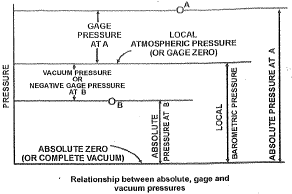
Absolute Pressure = Atm Pressure + Gage Pressure
Absolute Pressure = Atm Pressure - Vacuum Pressure
Q.176. In a structure, cables and wires are used generally as :
(а) To resist shear stress
(b) Tension member
(c) Compression member
(d) Flexural member
Ans. (b)
Solution.
In a structure, cables and wires are used generally as tension member.
Q.177. When the magnetic bearing of the sun at noon is 185°20', the magnetic declination will be
(a) 5°20' south
(b) 5°20' east
(c) 5°20' west
(d) 5°20' north
Ans. (c)
Solution.
True Bearing = Mag. Bearing ± Mag. Declination
+ ve for eastern declination
- ve for western declination
Now, Magnetic declination
= 185°20' - 180° = 5°20' W
Q.178. A RCC column is regarded as long column if the ratio of its unsupported length between end restraints to least lateral dimension is more than:
(a) 25
(b) 150
(c) 125
(d) 60
Ans. (d)
Solution.
The unsupported length between end restraints shall not exceed 60 times the least lateral dimension of a column.
Q.179. The height of instrument is equal to :
(а) Reduced level of bench mark - back sight
(b) Reduced level of bench mark + back sight
(c) Reduced level of bench mark + fore sight
(d) Reduced level of bench mark + Intermediate sight
Ans. (b)
Solution.
The height of instrument is equal to Reduced level of bench mark + back sight.
Q.180. Thickness of Plastering is usually
(a) 40 mm
(b) 6 mm
(c) 12 mm
(d) 25 mm
Ans. (c)
Q.181. Water absorption of Class I brick after 24 hours of immersion in water should not exceed ______ of self weight
(a) 25%
(b) 18%
(c) 20%
(d) 22%
Ans. (c)
Solution.
Water absorption of three different class of bricks are given below:
First class - Water absorption of first class bricks after 24 hours of immersion in water should not exceed 20 % of self-weight.
Second class - Water absorption of second class bricks after 24 hours of immersion in water should not exceed 22.5 % of self-weight.
Third class - Water absorption of third class bricks after 24 hours of immersion in water should not exceed 25 % of self-weight.
Q.182. For a given aggregate ratio increasing the water cement ratio :
(a) Increases the strength
(b) Decreased shrinkage
(c) Increases shrinkage
(d) Does not cause any change in shrinkage
Ans. (c)
Solution.
For a given aggregate ratio increasing the water cement ratio increases shrinkage and decreases strength.
Q.183. Granite is a rock that is by nature
(a) Metamorphic
(b) Volcanic
(c) Plutonic
(d) Sedimentary
Ans. (c)
Q.184. When the plastic limit of a soil is greater than the liquid limit, then the plasticity index is reported as :
(a) 1
(b) Negative
(c) Zero
(d) Non-Plastic (NP)
Ans. (c)
Q.185. Compression members always tend to buckle in the direction of the :
(a) Least radius of gyration
(b) Axis of load
(c) Perpendicular to the axis of load
(d) Minimum cross-section
Ans. (a)
Solution.
Compression members always tend to buckle in the direction of the Least radius of gyration. The radius of gyration (r) of a section is given by
Where I = moment of inertia
A = area of the section
Q.186. As per IS 456-2000. In the absence of test data, the approximate value of the total strain for design may be taken as :
(a) 0.004
(b) 0.001
(c) 0. 002
(d) 0.003
Ans. (d)
Solution.
In the absence of test data, the approximate value of the total strain for design may be taken as 0.003.
As per IS 456-2000. In the absence of test data, the approximate value of the total shrinkage strain for design may be taken as 0.0003
Q.187. Separation of water or water sand cement from a freshly mixed concrete is known as :
(a) Segregation
(b) Flooding
(c) Bleeding
(d) Creeping
Ans. (c)
Solution.
Separation of water or water sand cement from a freshly mixed concrete is known as bleeding
Q.188. 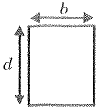 Moment of Inertia of rectangular section shown in Fig. about its base is :
Moment of Inertia of rectangular section shown in Fig. about its base is :
(a)
(b)
(c)
(d)
Ans. (c)
Solution.
Moment of inertia of the cross-section given rectangular section about its base -
By parallel axis theorem
About its base
Now
∴ 
Q.189. The correct prismoidal formula for valume calculation is :
(a) D/6 [first section area + last section ares + 2∑ even numbered section area + 4∑ odd numbered section area]
(b) D [first section area + last section area + Σ even numbered section area + 2∑ odd numbered section areas]
(c) D/3 [first section area + last section area + 4Σ even numbered section area + 2Σ odd numbered section area]
(d) D/3 [first section area + last section area + 2Σ even numbered section area + 4Σ odd numbered section areas]
Ans. (c)
Q.190. Zinc Oxide is a pigment having colour_____
(a) Blue
(b) White
(c) Yellow
(d) Red
Ans. (b)
Solution.
Zinc oxide is a pigment having colour white. Some of examples of pigments used to produce the desired colours are
| Pigment | Colour |
| Zinc oxide | White |
| Lamp black and ivory black | Black |
| Prussian blue, indigo | Blue |
| Chrome yellow, yellow orchre | Yellow |
| Burnt umber, burnt siena | Brown |
| Vermilion, red lead | Red |
| Copper sulphate | Green |
Q.191. The correction for sag is :
(а) Some times additive and sometimes subtractive
(b) Always additive
(c) Always subtractive
(d) Always zero
Ans. (c)
Q.192. The permanent deformation of concrete with time under steady load is called
(a) Visco -elasticity
(b) Vicidity
(c) Creep
(d) Relaxation
Ans. (c)
Solution.
The permanent deformation of concrete with time under steady load is called creep.
Q.193. Intersection method in plane table surveying is most suitable for :
(a) Plains
(b) Forests
(c) Urban areas
(d) Hilly area
Ans. (d)
Q.194. An aggregate is known as cyclopean aggregate if its size is more than :
(a) 75 mm
(b) 4.75 mm
(c) 30 mm
(d) 60 mm
Ans. (a)
Solution.
The size of aggregate is more than 75 mm then it is known as cyclopean aggregate.
Q.195. The centrifugal force on a car moving on a horizontal circular curve is proportional to:
(a) 
(b)
(c)
(d)
Ans. (a)
Solution.
The centrifugal force on a car moving on a horizontal circular curve
Where P = centrifugal force, kg
W = weight of the vehicle, kg
V - speed of vehicle, m/sec
Q.196. Using straight line method annual depreciation D is equal to
(a) Life in year-Scrap value/Original cost
(b) Scrap value - life in year/Original cost
(c) Original cost - life in year/scrap value
(d) Original cost - scrap value/life in year
Ans. (d)
Solution.
Using straight line method annual depreciation (D)
Q.197. If R and T are rise and tread of a stair spanning horizontally and steps are supported by wall on one side and by stringer beam on the otherside, the steps are designed as beam of width:
(a) 
(b) R + T
(c) T - R
(d)
Ans. (d)
Solution.
Width of step beam =
Q.198. Segregation in the concrete occurs when:
(a) Cement gets separated from mixture due to excess water
(b) Cement fails to give adequate binding quality
(c) Water is driven out of concrete at a faster rate
(d) Coarse aggregate tries to separate out from the finer material.
Ans. (d)
Solution.
Segregation in the concrete occurs when coarse aggregate tries to separate out from the finer material.
Q.199. Unit of second moment of area is :
(a) mm
(b) mm4
(c) mm3
(d) mm2
Ans. (b)
Solution.
Moment of Inertia is also called the second moment of area and its unit is mm4
Q.200. BOD test is conducted at a temperature of :
(a) Ambient temperature
(b) 15°C
(c) 20°C
(d) 27°C
Ans. (c)
|
2 videos|122 docs|55 tests
|
FAQs on SSC JE Civil Past Year Paper Technical - 2015 - Civil Engineering SSC JE (Technical) - Civil Engineering (CE)
| 1. What is the eligibility criteria for SSC JE Civil exam? |  |
| 2. What is the exam pattern for SSC JE Civil exam? |  |
| 3. What is the syllabus for SSC JE Civil exam? |  |
| 4. How can I prepare for the SSC JE Civil exam? |  |
| 5. Is there negative marking in the SSC JE Civil exam? |  |
|
2 videos|122 docs|55 tests
|

|
Explore Courses for Civil Engineering (CE) exam
|

|




















